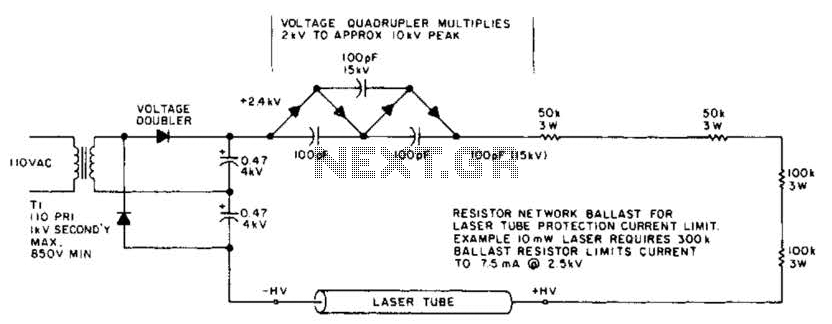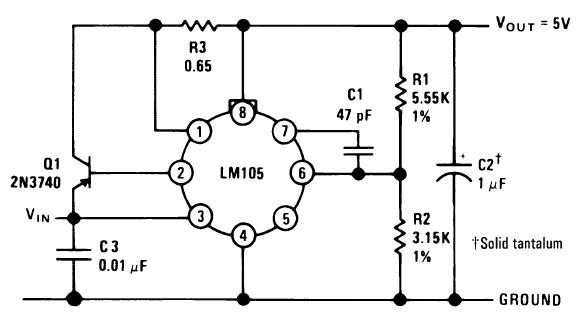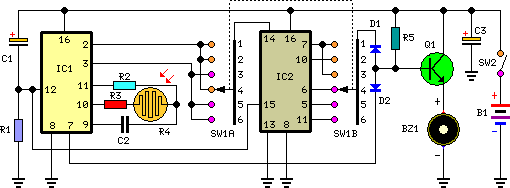
Laser Power Supply And Starting Circuit Circuit

This circuit delivers a peak voltage of 10 kV, while limiting the current to 7.5 mA at 2 kV. The resistors included in the design serve the purpose of ballasting. Additionally, the starting circuit is unable to sustain the 10 kV under load, functioning similarly to a series-pass circuit with minimal voltage drop.
The described circuit operates as a high-voltage power supply, specifically designed to deliver a peak output of 10 kV. The output voltage is crucial for applications requiring high voltage, such as gas discharge lamps or certain types of particle accelerators. The current limiting feature is essential to prevent excessive current flow, which could damage components or create unsafe operating conditions. The circuit limits the output current to 7.5 mA when the voltage is set at 2 kV, ensuring that the load is protected under normal operating conditions.
The inclusion of resistors for ballasting serves to stabilize the circuit by providing a controlled path for current flow, helping to manage the electrical characteristics of the load. Ballasting resistors are particularly important in high-voltage applications as they help to mitigate the effects of variations in load and protect against voltage spikes.
The starting circuit's inability to maintain the 10 kV under load indicates that it functions as a series-pass circuit. In this configuration, the circuit allows current to pass through while maintaining a relatively constant voltage drop across the load. However, under heavy load conditions, the output voltage may decrease due to the inherent limitations of the components used, such as the power transistors or diodes, which may not be rated for sustained high voltage operation.
Overall, this circuit design exemplifies the balance between high voltage output and current limiting features, ensuring safe and reliable operation in demanding electrical environments. Proper thermal management and component selection are critical to maintaining performance and longevity in such high-voltage applications. This circuit delivers 10 kV peak, then limits current to 7.5 mA @ 2 kV. The resistors shown provide ballasting. The starting circuit cannot maintain the 10 kV under load and appears as a series-pass circuit with little drop in voltage.
The described circuit operates as a high-voltage power supply, specifically designed to deliver a peak output of 10 kV. The output voltage is crucial for applications requiring high voltage, such as gas discharge lamps or certain types of particle accelerators. The current limiting feature is essential to prevent excessive current flow, which could damage components or create unsafe operating conditions. The circuit limits the output current to 7.5 mA when the voltage is set at 2 kV, ensuring that the load is protected under normal operating conditions.
The inclusion of resistors for ballasting serves to stabilize the circuit by providing a controlled path for current flow, helping to manage the electrical characteristics of the load. Ballasting resistors are particularly important in high-voltage applications as they help to mitigate the effects of variations in load and protect against voltage spikes.
The starting circuit's inability to maintain the 10 kV under load indicates that it functions as a series-pass circuit. In this configuration, the circuit allows current to pass through while maintaining a relatively constant voltage drop across the load. However, under heavy load conditions, the output voltage may decrease due to the inherent limitations of the components used, such as the power transistors or diodes, which may not be rated for sustained high voltage operation.
Overall, this circuit design exemplifies the balance between high voltage output and current limiting features, ensuring safe and reliable operation in demanding electrical environments. Proper thermal management and component selection are critical to maintaining performance and longevity in such high-voltage applications. This circuit delivers 10 kV peak, then limits current to 7.5 mA @ 2 kV. The resistors shown provide ballasting. The starting circuit cannot maintain the 10 kV under load and appears as a series-pass circuit with little drop in voltage.





